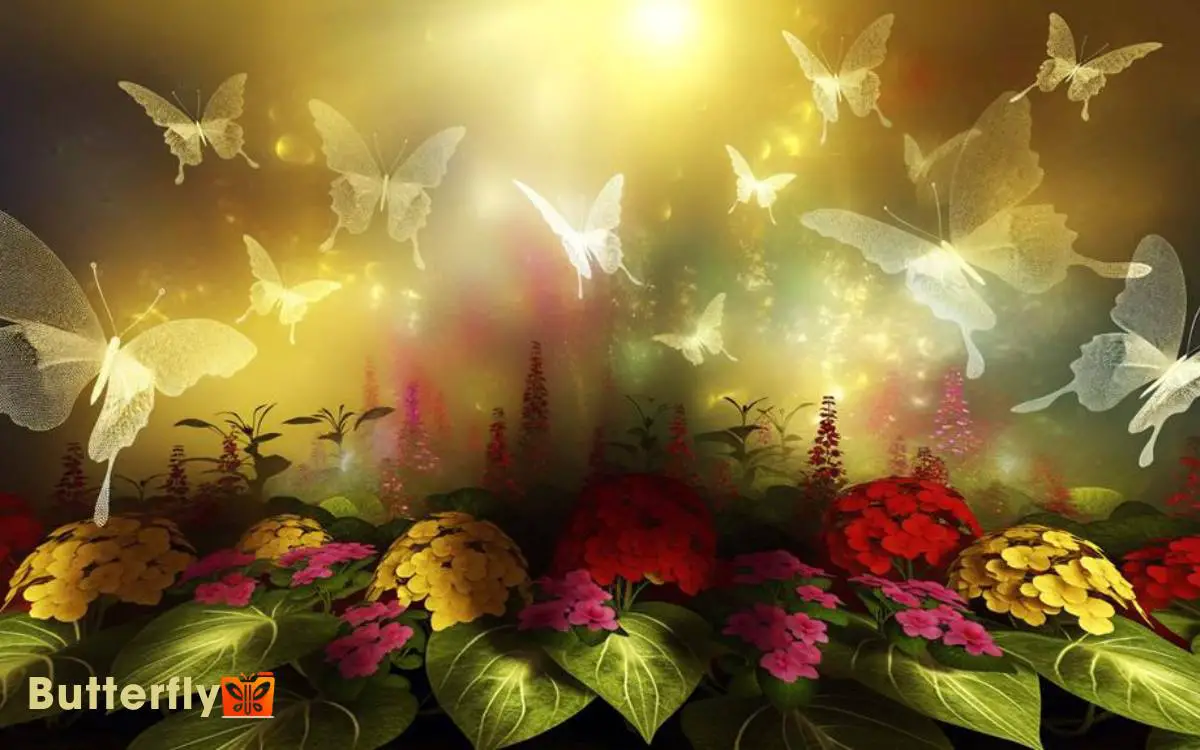Are Butterflies Signs From Heaven? Exploring Symbolism!
Butterflies often symbolize transformation and the connection between the earthly and divine. Culturally, they represent spiritual rebirth and the soul, especially in Greek and Chinese traditions.
Personal stories frequently mention butterflies during times of loss, suggesting an emotional and symbolic significance. Understanding these aspects can offer deeper insights into your experiences with butterflies. Explore further to discover more intriguing details.

Key Takeaways
Spiritual Interpretations
Many people interpret the appearance of butterflies as a spiritual sign, often believing they’re messages from deceased loved ones or divine beings.
This belief is grounded in the symbolic metamorphosis butterflies undergo, which can represent transformation and renewal.
Various studies in the field of thanatology, the scientific study of death and the practices associated with it, indicate that individuals often seek symbols in nature to cope with grief.
Observations have shown that butterflies frequently surface in anecdotal accounts of spiritual experiences, providing comfort during mourning. While empirical evidence supporting these claims is limited, the psychological impact of such symbols can’t be dismissed.
Recognizing these interpretations can help you understand the broader context of human responses to loss and transformation.
Cultural Symbolism
In many cultures, butterflies symbolize transformation, spiritual rebirth, and the connection between the earthly and divine spheres.
You’re likely aware that this symbolism emerges from the butterfly’s life cycle, which includes stages of metamorphosis: egg, larva, pupa, and adult. This process represents significant change and renewal.
For instance, in ancient Greek culture, butterflies were associated with the soul, known as ‘psyche.’ Similarly, in Chinese culture, they symbolize immortality and joy.
Evidence supports that these symbolic meanings are deeply rooted in historical and cultural contexts, reflecting human fascination with the butterfly’s dramatic transformation.
When you observe a butterfly, you’re witnessing a powerful metaphor for life’s cycles and the enduring human quest for meaning and connection.
Personal Stories
Numerous anecdotal accounts detail individuals encountering butterflies at significant moments, suggesting a profound connection between these experiences and emotional healing.
Many report seeing butterflies during times of loss, such as after a loved one’s passing, which they interpret as a comforting presence.
Others have observed these insects during moments of personal crisis or transformation, linking their appearance to a sense of reassurance. These personal stories, while subjective, offer a rich dataset for understanding the psychological impact of butterfly encounters.
Patterns emerge, indicating a possible correlation between butterfly sightings and a perceived emotional uplift. By cataloging these experiences, you can identify common themes and better appreciate the potential symbolic significance attributed to butterflies in personal narratives.
Seeing A Butterfly After Someone Dies
In various cultures and belief systems, encountering a butterfly after the death of a loved one can be interpreted as a meaningful and comforting sign.
While interpretations may differ based on personal beliefs, some individuals perceive such occurrences as a symbolic connection to the departed and a reminder of their continued presence in a spiritual sense.
For many, butterflies symbolize transformation, renewal, and the soul’s journey. In this context, seeing a butterfly after someone dies may be interpreted as a sign of the departed’s transition to a new state of being or as a message of hope and reassurance from the spiritual realm.
Some people find solace in the belief that the appearance of a butterfly is a form of communication from their loved one, conveying messages of love, peace, and guidance from beyond.
Others view it as a reminder of the beauty and interconnectedness of life and death, offering comfort during times of grief and loss.
Ultimately, the significance of seeing a butterfly after someone dies is deeply personal and may vary depending on individual beliefs, experiences, and cultural backgrounds.
For many, it serves as a poignant reminder of the enduring bond between the living and the departed, bringing a sense of comfort and spiritual connection during moments of mourning.
Butterflies As A Symbol Of Death
While butterflies are commonly associated with themes of transformation, renewal, and spiritual growth, in some cultures and belief systems, they are also interpreted as symbols of death or the afterlife.
In certain folklore or mythologies, butterflies are seen as messengers between the living and the dead. For example, in some Native American cultures, butterflies are believed to carry the spirits of the deceased to the afterlife.
Similarly, in Mexican culture, particularly during the Day of the Dead (Día de los Muertos) celebrations, butterflies are thought to represent the souls of departed loved ones returning to visit the living.
In literature and art, butterflies are sometimes used as symbols of mortality and the fleeting nature of life. Their short lifespan and transformation from caterpillar to butterfly are seen as metaphors for the cycle of life and death.
However, it’s important to note that interpretations of symbols can vary widely across different cultures and contexts. While some may view butterflies as symbols of death, others may see them primarily as symbols of life, beauty, and spiritual transcendence.
Ultimately, the symbolism of butterflies in relation to death is subjective and depends on individual beliefs and cultural perspectives.
Scientific Insights
Researchers have conducted various studies to uncover the mechanisms behind the psychological impact of butterfly encounters.
They’ve found that butterflies can trigger positive emotional responses through their vibrant colors and delicate movements. These visual stimuli can activate dopamine pathways, enhancing mood and reducing stress.
Additionally, the natural environment where butterflies are often found, like gardens and parks, contributes to a sense of tranquility and well-being.
Cognitive psychologists suggest that associations with transformation and beauty also play a role, as butterflies are symbolic of change and renewal.
While these findings don’t prove any spiritual connection, they do explain why you might feel a profound sense of peace and wonder when you see a butterfly. Understanding these scientific factors can enrich your appreciation of these experiences.
How to Connect
Understanding the psychological effects of butterfly encounters can guide you in creating meaningful connections with these enchanting creatures. Research indicates that such interactions can evoke positive emotions and a sense of tranquility.
To foster these connections, consider implementing the following strategies:
| Strategy | Psychological Benefit |
|---|---|
| Mindful Observation | Enhances focus and reduces stress |
| Creating Butterfly Gardens | Promotes environmental stewardship |
| Journaling Experiences | Increases emotional awareness |
| Symbolic Interpretation | Provides personal significance |
Conclusion
To sum up, when contemplating butterflies, it’s crucial to take into account scientific evidence. Personal anecdotes and cultural symbolism can enhance our comprehension, but we shouldn’t disregard the biological role and behavior of butterflies.
As the saying goes, ‘Seeing is believing,’ but always balance belief with scientific insight. By combining both perspectives, you can admire butterflies’ beauty and symbolic meaning in a comprehensive way.







Your words glow with authenticity — like candlelight in a quiet room.
https://xmc.pl